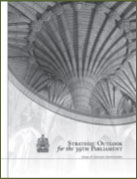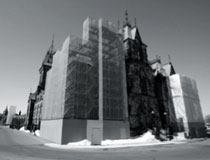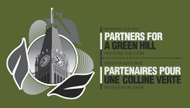Supporting Strategic Objectives
The Strategic Outlook for the 39th Parliament, published in 2006, identifies four strategic objectives for the House of Commons Administration that reflect its vision, values and mandate. It also provides a framework for its activities in support of Members.
The House Administration's strategic objectives are:
- Respond to the evolving role of Members and the institution
- Enhance ongoing services to Members and sustain the institution
- Promote understanding and support the advancement of legislative institutions
- Apply, in a parliamentary context, the highest standards of public-sector governance
This section of the Report to Canadians describes the House Administration's accomplishments during the 2007-2008 fiscal year in support of those objectives. It also identifies the Administration's major commitments for 2008-2009.
1. Responding to the Evolving Role of Members and the Institution
Canadian parliamentary democracy is always evolving in response to new challenges. The House of Commons Administration supports the efforts of all Members of Parliament to meet these challenges by providing new, innovative ways to access parliamentary information and by supporting the evolution of parliamentary practices and rules.

The Strategic Outlook is prepared at the beginning of each Parliament and outlines to Members the House Administration's strategic orientation and key commitments for the duration of the Parliament based on their needs. The latest version of the Strategic Outlook is available on the Parliament of Canada Web site at www.parl.gc.ca.
Supporting the Evolution of Parliamentary Practices and Rules
While the last year has seen only minor changes to the Standing Orders of the House, so many unusual and unprecedented events have occurred that there has been a significant impact on the precedents and practice. Updates are being made to procedural reference works and, in the meantime, procedural staff in the Administration stands ready to brief Members and their offices about the procedural options available to them in managing their business to meet their specific objectives. These briefings are strictly for information purposes; planning strategy is not within the purview of the non-partisan Administration but rather the work of political party advisers and researchers.
Improving Members' Access to Parliamentary Information
The administrations of the Senate, the House of Commons and the Library of Parliament continue to be governed by the principles of a common, long-term vision and strategy for enhancing parliamentary information services throughout Parliament. In the coming year, the Parliamentary Information Management Working Group, representing all three institutions, will continue to develop a governance model that defines roles and responsibilities so that all participants can work together effectively.
The House Administration is ensuring that Members have access to desktop information management tools to support them in their work. In 2007-2008, Members were provided with on-demand access to televised and audio proceedings via the ParlVU service. The "Today in the House" service also provides online information on the daily activities of the House of Commons, and this year, Members of Parliament were able to review the draft transcripts of proceedings (the "blues") from their portable devices (PDAs).
Work is under way on the second phase of Smart Book, a software tool to help publish both paper and electronic documents and to improve document workflow for International and Interparliamentary Affairs. Smart Book will also be used to manage and publish articles for the Compendium of House of Commons Procedure, making it easier to update and maintain this important online resource.
The Parliamentary Precinct Network has recently been upgraded in most buildings to ensure a more reliable and manageable service platform for the delivery of information services. In 2008-2009, the House Administration will complete the implementation of a secure, reliable and central information storage environment for Members. In addition, network services for Members' constituency offices are being renewed to provide fast and flexible communications services.
2. Enhancing Ongoing Services to Members and Sustaining the Institution
OUTREACH PROFILE
Organization for Security and Cooperation in Europe (OSCE) Conference
In 2008, Canada's Parliament will continue its longstanding practice of hosting parliamentary conferences in different regions of the country. From September 18 to 21, Toronto will welcome 250 delegates from the 56 member countries of the OSCE. This conference will provide an opportunity for parliamentarians from around the world to reflect on the challenges faced by OSCE members.
The House Administration has implemented a series of initiatives to enhance management and planning practices, as well as to upgrade technology services and facilities so that Members and employees can better serve Canadians in an efficient, effective manner.
Improving the Use and Application of Information Technology Services
By investing in technology services, improvements have been made to the financial and human resource systems of the House of Commons to make them more efficient in the management of information and in the way services are delivered.
This year, the House Administration completed the upgrade of the Human Resources Management System, making it easier for Members to maintain and manage resource-related information. In addition, a Human Resources Data Quality Program is being implemented to put in place controls, standards and processes to provide clients with higher quality information. Electronic forms used by Members for reporting travel expenses, hiring employees and other business-related activities have been modified to make them easier to use.
In 2008-2009, a pilot project will be launched so that Members can procure their office supplies electronically from their constituency offices and have their budgets updated simultaneously. Work will continue with the implementation of the Financial Management System upgrade and the Human Resources Data Quality Program. A Finance Data Quality Program will also be implemented in 2008-2009.
Improving the Committee Report Production Process
With its partners in the Library of Parliament and the Translation Bureau of Public Works and Government Services Canada, the House Administration reviewed and refined the process by which committee reports are produced. This initiative helped streamline decision-making and better coordinate the monitoring and timely production of the reports.
Managing the Members' Orientation and Election Readiness Program
The Members' Orientation and Election Readiness Program ensures the timely and coordinated delivery of administrative, financial and procedural information and services required by Members of Parliament before, during and after general elections and by-elections. Building on lessons learned from previous elections, the House Administration is implementing a more rigorous and structured governance approach and is improving services to new Members. The Program has recently become part of the Secretariat to the Board of Internal Economy.
Enhancements to Web Site for Committees
Building on the approach taken with the "Today in the House" service, enhancements have been made to the Web site for committees. These enhancements meet accessibility standards, provide a common "look and feel", make it easier to maintain the site, and provide better access to information about committee activities, members and witnesses.

Renovating the Parliamentary Precinct buildings.
Photo: © House of Commons / Bernard Thibodeau
Guides for Chair Occupants and Table Officers
The House Administration prepared a new edition of a guide for Chair Occupants. Scheduled to be printed in 2008, Practical Advice: Guide for Chair Occupants will be available in an abridged format so that it can be accessed quickly by Presiding Officers when managing debates in the House.
Renovations of the Parliamentary Precinct
The House Administration continues to strive to meet the key objectives of the Long-Term Vision and Plan (LTVP) for the Parliamentary Precinct. This plan serves to ensure that Members are housed in facilities that meet the demands of a modern workplace while minimizing the impact of Parliamentary Precinct renovations on operations and services. In addition, the LTVP respects the historical significance and beauty of the Parliament Buildings and grounds-preserving them while preparing for future needs. The LTVP involves a close partnership with Public Works and Government Services Canada, since parliament is a tenant of the buildings of the Precinct and the Hill.
Planning continues on the major rehabilitation of the West Block, with restoration work underway on the southeast and north towers. Renovation work is progressing to provide interim space for Parliamentarians' offices and for committee rooms, displaced from the West Block to enable the rehabilitation of the building to proceed.
Business Continuity Planning
Ongoing planning ensures that the vital business of the Chamber and committees can continue in the event of an emergency situation in which the House of Commons is required to relocate. Critical service needs of all the areas of the House of Commons have been identified.
Supporting Parliamentary Security
To support security awareness activities within the Parliamentary Precinct, the House Administration published and conducted presentations on security tips and protocols. This information is integrated into House of Commons security practices, and is maintained and assessed regularly.
The Parliamentary partnership of security representatives from the Senate, the House of Commons, and the RCMP provides strategic orientation on security issues to align with the Long-Term Vision and Plan of the Precinct, while maintaining appropriate security practices in daily operations.
3. Promoting Understanding and Supporting the Advancement of Legislative Institutions
Promoting a Broader Understanding of Parliament
To ensure a broader understanding of Parliament among a wide range of clients, including the media as well as professional and academic organizations, the House Administration is working on the second edition of House of Commons Procedure and Practice-a comprehensive study of House of Commons procedural rules and precedents. The new edition, which is scheduled for publication in 2009, will take into account changes to the Standing Orders and practices of the House of Commons that have occurred since the first edition was published in 2000.
Providing Learning Opportunities
Training sessions on parliamentary procedure continue to be offered by the House Administration to a range of clients, including Members of the House of Commons and their staff. An in-depth, intensive version of this training is also provided to new senior staff of the House Administration. In conjunction with the Senate and the Canada School of Public Service, the House Administration provides training sessions explaining the functions and rules of Parliament to employees of the federal public service.
4. Applying, in a Parliamentary Context, the Highest Standards of Public-sector Governance
As part of ongoing efforts to ensure accountability and transparency to Canadians, the House of Commons implements a range of management processes and best practices that promote responsible stewardship of resources.
Implementing the Chief Financial Officer Model
Visit the Parliament of Canada Web site at www.parl.gc.ca to learn more about the legislative process and the activities of the House of Commons.
With the renewed emphasis on sound financial management throughout the public and private sectors, the House Administration's Finance Services is implementing the Chief Financial Officer (CFO) Model. Implementing this model will help ensure that the people and infrastructure are in place to provide the best possible service to Members. The CFO model will achieve this by:
- delivering effective financial strategies through modern systems, internal controls and best practices;
- generating high-quality, integrated financial information;
- measuring performance and identifying areas for improvement; and
- reducing transactional activity by leveraging technology.
OUTREACH PROFILE
Partners for a Green Hill

Canadians consider environmental protection a core value and Parliament is gladly willing to do its part. Through a program called Partners for a Green Hill, established in 2004, the Senate, House of Commons and Library of Parliament joined forces to further good environmental stewardship of the Parliamentary Precinct. It is a commitment to preserve and enhance the Parliament Hill environment by implementing the "4Rs" of environmental protection: Reduce, Reuse, Recycle and Rethink. It also aims to raise public awareness about the importance of preserving and protecting the environment-including the Parliamentary Precinct. The program involves all buildings within the Parliamentary Precinct housing more than 4,000 people who work in this area, including parliamentarians and their staff, employees of the Administration of the Senate, the House of Commons and the Library of Parliament, and the public.
The House Administration is implementing an integrated investment-planning framework. The framework enhances the planning process that ensures investments are made strategically, factoring in needs, costs, risks, sources of funding, investment options and intended impacts. In 2007-2008, the House of Commons initiated its first formal cycle of integrated investment planning, with the preparation of a Five-Year Investment Plan (2009-2013).
With respect to financial reporting, the House Administration's financial statements continue to be audited by an external firm. In 2007, an unqualified audit report was issued. As part of the CFO Model's objective to create the conditions for generating high-quality financial information, several quality assurance reviews were conducted, including financial and post-payment reviews.
Based on a multi-year policy plan that guides policy review and development, the House Administration reviewed the requirements and limits for delegation of authority and the rules governing official gifts, as well as the policy that governs the receipt, control and deposit of cash. A revised procurement policy is also being developed to control costs and risks associated with the procurement process.
Over the course of the 2008-2009 fiscal year, additional activities are scheduled as part of the multi-year policy plan. An asset management policy will be developed. This will establish a reporting and accountability framework to facilitate optimal asset performance. In addition, financial management and policy guides for committees, parliamentary associations and parliamentary exchanges will be examined, as well as policies governing the recovery of property and privileges of departing employees.
Sustaining a Modern and Effective Workforce
The House Administration continues to plan and implement a number of activities to ensure that it remains a competitive employer with a thriving workforce. Several initiatives have been implemented to respond to the growing challenges in human resources management, including measures to attract new employees and support for the current workforce through training and leadership development. These steps will ensure that House Administration employees have the skills necessary to meet the needs of Members today and in the future.
Focus on Employees' Potential: Talent Management
Competency profiles were developed to reflect the skills required for managers, supervisors, language instructors and administrative positions within the House Administration. These profiles were based on information gathered at focus groups and in interviews conducted with incumbents and their managers. In addition, human resource specialists administered competency-based evaluation tools, conducted learning needs assessments, and provided individual and collective learning plans in various service areas.
The next year will see the alignment of the competency profiles with the development of a leadership program to ensure that all employees can deploy their talents and contribute to the success of the organization. A structured succession planning program will also allow the organization to ensure the transfers of knowledge and corporate memory, thus continuing to provide quality service and information to Members.
Focus on Client Requirements: Service Delivery
To address a shrinking pool of top talent, innovative programs were developed to attract new employees. Recruitment was promoted by participating in job fairs and posting job opportunities on the Parliament of Canada Web site, reaching more potential candidates and adapting to the culture of a new generation.
New initiatives in occupational health and safety include developing a corporate response plan to deal with pandemic situations, implementing health-risk assessments to assist staff in addressing work/life balance issues, and establishing an integrated conflict management system to foster a workplace where conflicts can be resolved in a constructive manner.
Focus on the Institution's Needs: Stewardship
The House of Commons aspires to become an environment of choice. Consultations were held regarding human resources policy development, in order to review and streamline key business processes and report on performance efficiently. A corporate report on employment equity, tabled at the Board of Internal Economy, defines strategic initiatives that will allow the organization to adjust its priorities to ensure that the House recruits and retains a proportional representation of the four designated employment equity groups. New reports on human resources management in the House Administration will be developed to provide accurate and timely data for optimal decision-making.
Ensuring Information Resources are Readily Available
The House Administration has established a central records office and has completed an inventory and review of current and archived print information. This review included developing and implementing a classification structure aligned with the House of Commons Subject Classification Scheme, as well as retention and disposition schedules.
Environmental Management
DID YOU KNOW THAT…
Since Confederation, Canada has been served by 12 Clerks of the House of Commons. Audrey O'Brien, the current Clerk, is the first woman to occupy the position.
Partners for a Green Hill will continue to promote new programs and initiatives to improve environmental management on Parliament Hill, including conducting a review of the use of chemical products, promoting the transit-pass program for employees, and expanding recycling programs to divert more waste from landfill sites. An audit of environmental management programs in 2007-2008 showed that the House maintained a rate of 83% diversion of waste products from landfill. Also, stringent environmental criteria have been incorporated into the tendering process for the purchase of paint.
Parliament Hill Plan

1 Peace Tower
2 Centre Block Main Entrance
3 The Library of Parliament
4 West Block
5 East Block
6 The Centennial Flame
Graphic: Library of Parliament / Barb Wood



